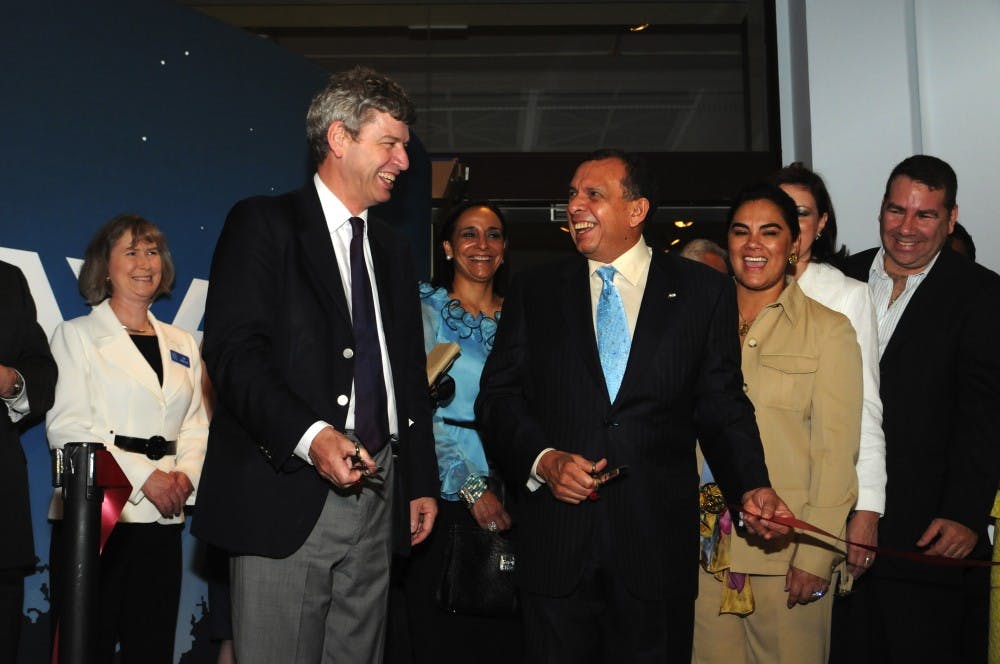Simon Martin, co-curator of a new Mayan exhibit, is asking: what is 2012 all about?
“So much of it doesn’t make any sense. But maybe it does! I don’t know!”
MAYA 2012: Lord of Time is trying to answer this question. The world premiere exhibit opened at the University of Pennsylvania Museum of Archaeology and Anthropology on Saturday with a ribbon cutting ceremony, lectures and lunch.
Honduran President Porfirio Loba Sosa and First Lady Rose Elena de Lobo were present for the opening ceremony. Lobo, in his speech, recognized the relationship between Honduras, the United States, Philadelphia and Penn.
The exhibit was made possible by a partnership with the Instituto Hondureño de Antropologia e Historia of the Republic of Honduras and a major grant from the National Endowment of the Humanities. It confronts a complex series of questions about the ancient Maya civilization and 2012 — the year they predicted to be the universe’s end.
“So much of it is contradictory,” said Martin, a Mayan scholar, epigrapher and historian at Penn.
Much of this uncertainty may be attributed to sensationalism by the media. At the exhibit’s entrance, television screens and newspaper clips serve as examples of how the media have contributed to the hype and fascination with the predicted 2012 apocalypse.
Through video kiosks and informational panels, experts contexualize and explain away misconceptions about the apocalypse.
One of these experts, Ricardo Agurcia, who considers himself a “dirt archaeologist,” sees the question of 2012 having broader implications about the ways perceptions and cultural understandings of the Maya have changed over time.
“We still think of the Maya as a star gazing people who lived in empty ceremonial centers mostly run by priests,” he said. “But all of the research we have done has really contributed to seeing just how human the Mayans were and how similar they were to kingdoms all over the world.”
Guests can learn about the meaning and methods of Mayan writing and learn how to write their name in glyphs. They can also participate in virtual archeological digs.
But the experience is only partly virtual. The exhibit offers an extensive collection of exclusive pieces including a stone figure of the maize god.
The piece was excavated in Copan, Honduras in 725 C.E. and represents the mythical source of food and fertility. It is similar to the figures that sprout from the upper facade of Mayan temples.
The bound paper and ink of the Books of Chilam Balam, the most important Maya documents from the northern region of the Yucatan Peninsula, are also exclusively on display, on loan from Princeton University. The texts were written some time after the Spanish Conquest and contain prophecies, as well as significant historical and religious information.
Special monumental reproductions are also displayed like the Quiriguá Stela C which features the date ancient Maya believed the current universe was created.
The final museum corridor introduces guests to an overview of the over seven million Maya who live in Central America and Mexico today, including video testimonies from Maya civic leaders, archaeologists and experts who discuss the culture of a civilization that still thrives today.
MAYA 2012: Lord of Time was supposed to feature a 25-ton sand project — a re-creation of Altar Q, a famous Mayan monument in Honduras — at The Porch near 30th Street Station.
The sculpture was to be created on a Pennsylvania Department of Transportation bridge structure, which required certain approvals that didn’t give enough time for the project’s sculptors.
MAYA 2012: Lords of Time is open to the public for a fee and to PennCard holders for one free visit. It will remain open until January 13, 2013



